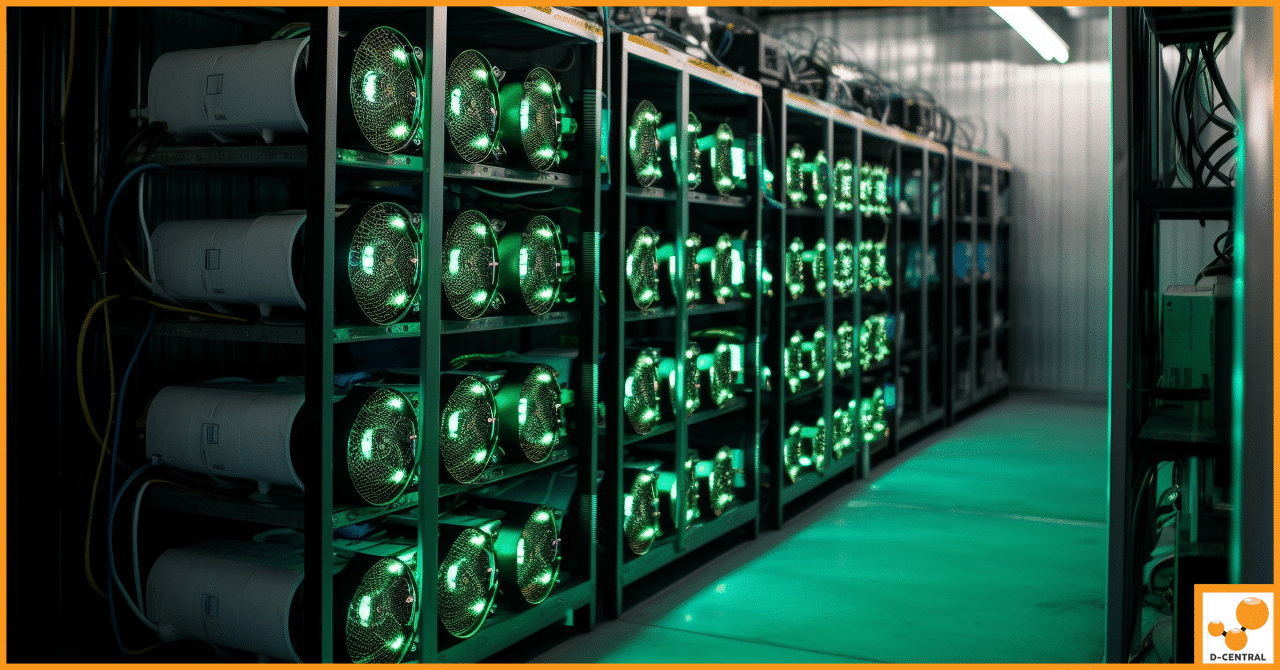
Waste to Wealth: How Bitcoin Miners Can Heat Public Buildings
In the digital age, Bitcoin has emerged as a revolutionary cryptocurrency, offering a decentralized alternative to traditional banking systems. At
4479 Desserte Nord Autoroute 440, Laval, QC H7P 6E2

As the world moves towards greater sustainability, industries are exploring creative ways to reduce their environmental impact. One such approach is harnessing the heat generated by cryptocurrency mining operations and using it to maintain temperature levels in chemical storage facilities. This innovative concept offers a cost-effective and energy-efficient solution for both Bitcoin miners and chemical storage facilities, while also creating potential new business models. In this blog post, we’ll explore the benefits, challenges and considerations of using Bitcoin miners’ excess heat in chemical storage facilities.
Harnessing the excess heat produced by cryptocurrency mining operations is gaining traction in the industrial sector as an alternative to traditional heating methods. By using Bitcoin miners’ excess heat to maintain temperature levels in chemical storage facilities, organizations can benefit from reduced heating costs and improved energy efficiency. This approach also creates a synergy between industries, allowing for new business models that can generate additional revenue streams for both parties. However, there are some challenges and considerations that must be taken into account when utilizing this solution, including regulatory compliance, infrastructure integration, and reliability/consistency of the supplied heat. As the world moves towards more sustainable solutions, harnessing cryptocurrency mining heat for chemical storage could provide a cost-effective and efficient alternative that all industries should consider.
– Cost savings in heating expenses
– Improved energy efficiency
– Increased collaboration between industries
– Development of new business models for additional revenue streams
Developed innovative concept of utilizing excess heat from cryptocurrency mining operations to reduce heating costs and improve energy efficiency in chemical storage facilities, while taking into account challenges such as regulatory compliance, infrastructure integration, and reliability/consistency.
Regulatory compliance is essential when utilizing the excess heat from Bitcoin mining operations in chemical storage facilities to maintain consistent temperature levels. Both industries must comply with strict regulations and standards to ensure the safety and stability of the stored chemicals. The relevant government authorities must be consulted to ensure that all facility requirements are met, including temperature ranges, ventilation systems, and waste disposal procedures. To minimize risk and ensure a safe environment, facility owners must also keep detailed records of their operations, such as logs of temperature readings and inspection reports. Additionally, operators should consider implementing a real-time monitoring system for their Bitcoin miners’ heat supply to ensure its quality and consistency. All these measures will help guarantee a safe and compliant use of excess heat from Bitcoin mining operations in chemical storage facilities.
Infrastructure integration is a key factor to consider when utilizing the excess heat from Bitcoin mining operations in chemical storage facilities. To ensure compatibility with existing systems, facility managers must assess the infrastructure requirements of both industries, including power sources, cooling systems, and ventilation networks. The necessary components should be identified and evaluated for their ability to meet the requirements of both industries and provide a cost-effective solution.
Integrating Bitcoin miners’ heat into existing infrastructure requires careful planning and precise execution. Facility owners must consider factors such as temperature ranges, air circulation, pressure levels, and electrical wiring before integrating their current systems with the new source of heat. Any modifications to existing infrastructure should be made cautiously to minimize downtime or disruption to operations. To maximize energy efficiency and reduce costs, facility operators should also consider installing energy management tools such as sensors, controllers, and timer switches that can automatically adjust temperature settings based on environmental conditions.
The reliability and consistency of heat supplied by Bitcoin mining operations must also be evaluated before making any infrastructure changes. Facility owners must ensure that their current system can handle the increased load while maintaining quality standards at all times. Moreover, they should investigate ways to mitigate potential risks such as power outages or other disturbances that could affect operations. By assessing these factors beforehand, facility owners can guarantee an effective integration of cryptocurrency mining heat into existing structures that meets both industry standards and sustainability goals.
The collaboration between the Bitcoin mining and chemical storage industries presents numerous opportunities for new business models that can benefit both sectors. For instance, facility owners could create a partnership to share resources such as electricity, cooling systems, and ventilation networks. This would enable them to reduce operational costs while maintaining high standards of safety and quality control. Additionally, the real-time monitoring system developed for Bitcoin miners’ heat supply provides new possibilities for streamlining operations. This technology could be used to automatically adjust temperature settings according to environmental conditions and prevent temperature fluctuations that could impact the stability of stored chemicals.
In addition to reducing overhead costs, such collaborations could open up new markets for both industries. For example, chemical storage facilities may be able to offer services such as temperature-controlled storage or even cryogenic storage services utilizing excess heat from Bitcoin mining operations. Likewise, Bitcoin miners can benefit from having access to a reliable source of heat at a low cost, which they can then use to power their mining activities more efficiently.
Furthermore, the sustainability benefits of harnessing cryptocurrency mining heat are another attractive factor that could contribute towards developing new business models. As companies strive towards becoming more eco-friendly and energy efficient, the utilization of renewable energy sources presents lucrative opportunities that previously may have been out of reach due to cost constraints. In this context, utilizing excess heat from Bitcoin mining operations in chemical storage facilities not only benefits both industries but also contributes towards broader environmental goals by reducing emissions and promoting sustainability practices across industries worldwide.
The collaboration between the Bitcoin mining and chemical storage industries has presented numerous opportunities for new business models that can benefit both sectors. The potential of harnessing cryptocurrency mining heat to improve sustainability and energy efficiency in chemical storage facilities is an attractive factor, as it not only benefits both industries but also contributes towards broader environmental goals by reducing emissions and promoting sustainability practices across industries worldwide. This model can be adopted and adapted by other industries looking for sustainable solutions, enabling them to reduce operational costs while maintaining high standards of safety and quality control at all times. Ultimately, this could result in a more efficient use of resources with increased access to renewable energy sources, allowing companies to become greener without compromising on their bottom line or customer satisfaction.
What are the benefits of using Bitcoin miners’ heat in chemical storage facilities?
Using Bitcoin miners’ heat in chemical storage facilities offers several benefits, including cost savings in heating expenses, improved energy efficiency, increased collaboration between industries, and the development of new business models for additional revenue streams.
What are the challenges and considerations when utilizing this solution?
When utilizing Bitcoin miners’ heat in chemical storage facilities, there are several challenges and considerations to take into account. These include regulatory compliance for safe use, infrastructure integration to ensure compatibility with existing systems, and the reliability and consistency of the heat supplied by Bitcoin mining operations.
How does regulatory compliance factor into utilizing Bitcoin miners’ heat in chemical storage facilities?
Regulatory compliance is essential when using Bitcoin miners’ heat in chemical storage facilities. Both industries must comply with strict regulations and standards to ensure the safety and stability of the stored chemicals. It is important to consult with relevant government authorities to ensure all facility requirements, including temperature ranges, ventilation systems, and waste disposal procedures, are met.
What should be considered when integrating the infrastructure for using Bitcoin miners’ heat?
Infrastructure integration is a crucial factor to consider when using Bitcoin miners’ heat in chemical storage facilities. Facility managers must assess the infrastructure requirements of both industries, including power sources, cooling systems, and ventilation networks. Modifications to existing infrastructure should be made cautiously to minimize disruption to operations and maximize energy efficiency.
What potential business models can be developed through the collaboration between the Bitcoin mining and chemical storage industries?
The collaboration between the Bitcoin mining and chemical storage industries presents opportunities for new business models. Facility owners can create partnerships to share resources, such as electricity and cooling systems, reducing operational costs. The real-time monitoring system developed for Bitcoin miners’ heat supply can also streamline operations and prevent temperature fluctuations that could impact the stability of stored chemicals.
How does utilizing Bitcoin miners’ heat contribute to sustainability goals?
Utilizing Bitcoin miners’ heat in chemical storage facilities contributes to broader environmental goals by reducing emissions and promoting sustainability practices. It allows industries to utilize renewable energy sources and become more eco-friendly and energy-efficient, which was previously challenging due to cost constraints.
DISCLAIMER: D-Central Technologies and its associated content, including this blog, do not serve as financial advisors or official investment advisors. The insights and opinions shared here or by any guests featured in our content are provided purely for informational and educational purposes. Such communications should not be interpreted as financial, investment, legal, tax, or any form of specific advice. We are committed to advancing the knowledge and understanding of Bitcoin and its potential impact on society. However, we urge our community to proceed with caution and informed judgment in all related endeavors.
Related Posts

In the digital age, Bitcoin has emerged as a revolutionary cryptocurrency, offering a decentralized alternative to traditional banking systems. At

Bitcoin mining, the backbone of cryptocurrency validation and creation, is a process that has captivated enthusiasts and investors alike. At

In the rapidly evolving world of cryptocurrency, ASIC (Application-Specific Integrated Circuit) miners have emerged as the backbone of mining operations,